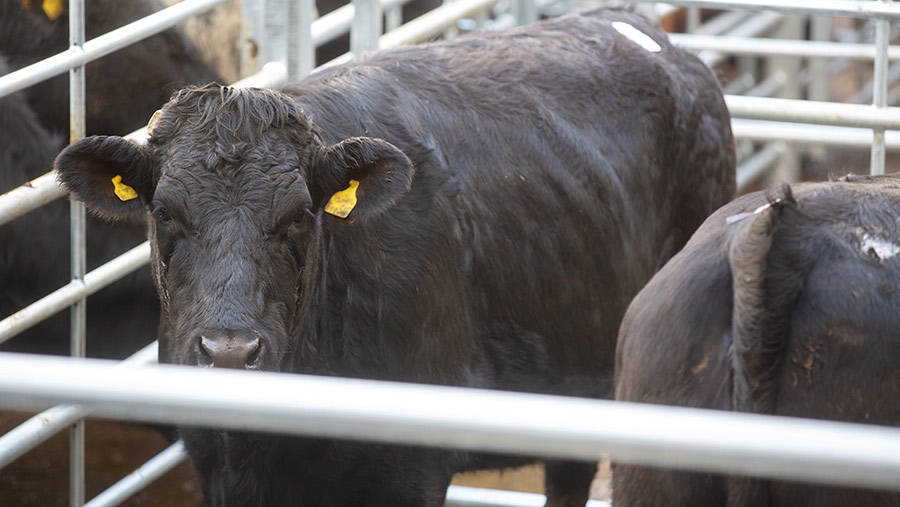Beef price lift could save value ‘correction’ on stores
 © Tim Scrivener
© Tim Scrivener Store cattle prices could face pressure as summer gets going unless deadweight buyers can offer a beef price that keeps pace with exorbitant cost increases.
Last year’s cereal will eventually all be fed, and, as more feeders are exposed to spot markets and contracts set since the start of the war in Ukraine, store cattle values could be the only place to chisel out a margin if processors are unable to lift trade.
This is according to Sedgemoor Auction Centre’s Robert Venner of Greenslade Taylor Hunt, who said a higher beef price would be necessary, or there could be “a correction” in store cattle values.
See also: Beef price hike needed to safeguard summer supply
It is a stark outlook, but if some finishers opt to sell more grain and finish fewer cattle, this will inevitably lead to fewer hands waving around the rings and potentially depress cattle prices, he added.
But any suggestion of lower calf and store prices would be a further blow during a period of suckler contraction, which industry leaders say justifies government intervention.
Last week National Beef Association lead Neil Shand slammed the “ludicrous” gap between Scotland’s suckler calf scheme (about £100 for every three-quarter-bred suckler calf born and retained for 30 days, and £145 on the islands) and the lack of any English support.
Mr Shand called for an English headage payment with an efficiency enhancement for performance gains to halt contraction of England’s herd, which has fallen more than 7% since 2018.
Difference between average GB store cattle prices in late May/early June 2021 and 2022 |
||||
|
Continental and continental-cross cattle |
28 May 2022 (£/head) |
Difference on the year |
4 June 2022 (£/head) |
Difference on the year |
|
Yearling steers |
996.51 |
+1.03% |
944.40 |
+6.95% |
|
Yearling heifers |
890.39 |
+1.09% |
843.13 |
+6.3% |
|
18-month steers |
1,067.57 |
+8.4% |
1,027.02 |
2.48% |
|
18-month heifers |
974.46 |
+8.74% |
934.42 |
+6.39% |
|
2-year steers |
1,252.48 |
+15.8% |
1,214.40 |
+11.75% |
|
2-year heifers |
1,129.95 |
+10.2% |
1,102.22 |
+7.2% |
| Source: AHDB | ||||
Record cattle and costs
Only very short-term cattle prices have noticeably inflated (see table), with trade for younger cattle only a smidgen ahead on the year, according to AHDB data.
Short-keep store cattle have been up to 10-15% dearer on the year, while younger store cattle were only 2-6% dearer on average at the start of June. This is despite an 11% lift in beef price over the same period, with an R4L averaging about 447p/kg in Great Britain at the start of June.
However, Mr Venner said cattle availability across mainland Europe, and Ireland (where base prices had hit 462p/kg), suggested the market was being supply driven, with little reason to think beef prices would struggle.
“We are coming into beef and beer season and the supermarkets are really pushing it now – it gets people through the door,” he said.
“I think there’s room for the UK deadweight price to rise. We have had record cattle prices at Sedgemoor, but farmers’ costs are hitting records too.”
Oliver Shearman of Caledonian Marts, Stirling, said there was very little difference in price for an R- or a U-grade animal. This week’s (13 June) store sale of 247-head saw short-keep U-grade cattle at about 235p/kg.
Good suckler-bred Limousin-cross bullocks at 360kg (277p/kg) or more had made £1,000, and heifers had made £910-£920 a head.
Breeders make splitting price
Cost pressures have limited expectations at breeding sale rings, with auctioneers saying that without a record cull price, trade could have been bleak.
Cattle auctioneer Drew Patrick of Hexham and Northern Marts said the cost of keeping a cow for one vendor has increased from £450 a winter to £650 a winter since 2020.
“Only the better ends of outfits have been making more on the year and it’s perhaps only £40-£50 an outfit more,” said Mr Patrick. “The biggest issue now is input costs – they are killing the industry. Fuel has gone up again this week, and with wheat at £350/t you can’t be feeding that to stock and get the same returns as people managed with last year’s grain.”
Best continental heifers and calves had hit £3,200-£3,500 and some shapely third and fourth calvers had made £2,400 with a strong calf.
But Mr Patrick said a lot of commercial outfits had made £1,800-£1,850, which was indicative of “splitting money”, with the calf weaned and the cow cashed in the cull ring.
At Stirling, Mr Shearman said some cows bought a couple of years ago with a calf had been sold this spring for more money as a cull.
The numbers
35%
How much of Brazil’s beef is expected to be exported, this is up from 20% historically (Radar Investments)
+£33.25
How much dearer a 350kg steer carcass is in Ireland compared with the UK, at a base price about 10p/kg higher (BordBia)
11
How many years since the last time Ireland’s beef prices were above GB prices (BordBia)
